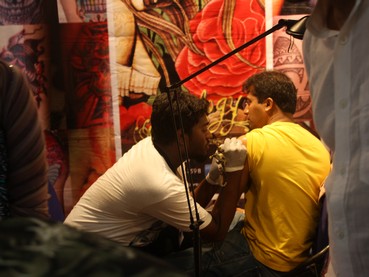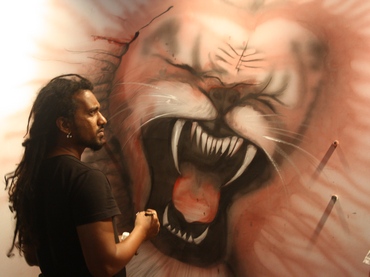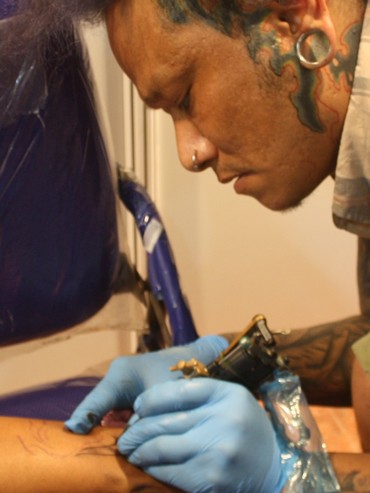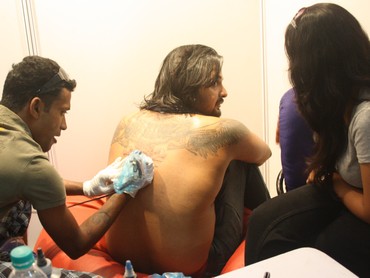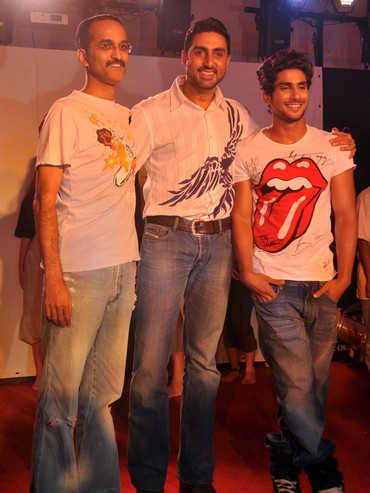 | « Back to article | Print this article |
The priest who became a tattoo artist
A bohemian Nepali, a south Indian priest and a mechanical engineer are bound by their mutual love for tattooing as an art form. These young men however are no longer on the margins as tattooing is being accepted in the mainstream more than ever.
The business district of South Mumbai wears a sleepy look. Most businesses are shut.
At the World Trade Centre in Cuffe Parade, the guards look relaxed. On the first floor of the Arcade, which houses a convention centre, things are just beginning to warm up.
Indian Ink, the country's first ever tattoo convention has just gone underway an hour ago. Tattoo artists from across the country have converged for this first-of-its-kind event in perhaps the most unlikely place.
Heavily tattooed women and men walking past the security elicit suspicious glances from the few corporate executives who have stepped out for a quick smoke and chai.
By 2015, half of Mumbaikars would have at least one tattoo
Mohan Gurung has tattoos all over his hands, feet and every single inch of space he could squeeze out on his body. There's even a tattoo on his shaven head that goes around his right ear.
He requests me to speak into his right ear. "I cannot hear from my left one, lost it after an accident," he says gesturing with his hand suggesting it was a motorcycle that crashed somewhere in Nepal.
Gurung has flown in from Kathmandu where he is based to participate in this convention -- he holds the distinction of having organised the first one in Nepal.
The 38-year-old tattoo artist has a bohemian air about him. He doesn't speak much English and confesses he's a terrible subject to interview but he's as aware as everyone else in the room that the tattoo as an art form is beginning to catch up in India. And it isn't just the hip and happening urban folks that are taking to it.
I agree with him. My newspaper vendor, a young boy in his early 20s, has been in the process of getting an elaborate tattoo of his girlfriend's name on his right arm.
Call it the ripple effect of Saif Ali Khan strumming an electric guitar dramatically with 'Kareena' inked all over his hand but tattooing has been reaching more people than ever.
A recent newspaper headline claimed that by 2015, half of Mumbaikars would have at least one tattoo.
And as the numbers of those wanting to get a tattoo are ever on the increase, those who are making this as a full time profession are also on the rise.
'The young don't pay heed to safety and hygiene'
According to a tattoo artist, if one is good at what s/he is doing, making about Rs 30-40k per month isn't very difficult. At the convention among the ones we spotted, there was a temple priest and even a mechanical engineer who quit his job to tattoo full time!
Bringing these varied people under one roof is Shibanii Shah, the 25-year-old entrepreneur who is organising this convention. She tells me that the idea of having this convention is to spread awareness about the art and spread awareness amongst people dying to be cool.
"I've seen a lot of young people getting tattoos without so much paying any heed to safety and hygiene. Besides providing a platform for tattoo artists across the country, we're hoping this would make people more aware of the dos and don'ts of getting a tattoo.
'I was branded with hot iron'
Girish waits outside his stall. Two huge suitcases lie unpacked on the table as his assistant, a dark lanky boy who insists on wearing a hooded t-shirt with the hood on, hovers around.
He has a shaven head, wears a red tilak and a fancy watch.
Girish's arms have over 30 tattoos in all.
Some of them are Hindu motifs like the mandala, omkara and chakra, others seem like sculptures from temple art -- apsaras in a dance pose -- and even others are just writings that read 'Jai Shri Ram' or are verses from the Vedas.
Like Mohan Gurun 36-year-old Girish -- he tells me he doesn't have a second name -- is also here to be part of the convention.
"Don't shoot pictures of the tattoo details," he says, "They're all customised."
It turns out Girish is a temple priest -- or rather used to be till he decided to step out of his village and explore options beyond the daily rituals.
He got the first two tattoos -- a mandala and a chakra -- after similar marks on his arms began to fade out.
"When I was initiated into the fold, I was branded with hot iron. As I grew older and the marks went away I began to look at getting something permanent," he recollects.
Much to the horror of his parents and other elders in the family, he turned to tattooing. It was blasphemy.
"I tried to tell them it wasn't against the religious code," he says bemusedly.
Girish stood vindicated as they were told it wasn't. Mehndi for instance is a form of tattooing.
'Tattoos can heal'
In the Mahabharata, Krishna is said to have left a mark on the palm of his queen Rukmini's hand with his chakra as a symbol of protection against the evil eye. Tattoos have medicinal values and if they're done correctly have healing effects," he says going on to explain to me the various points of power along one's spine and the positive effects of an Omkara tattoo on the back of one's neck and a lotus on a certain spot on the back.
Currently Girish has set a target of tattooing 10,000 Omkaras on people. He's crossed a little over 1,000 and has been offering to paint one for free. His only condition: "It should be on the right arm."
This engineer quit his job to tattoo
A few stalls away from Girish's, Veer Hegde is poring over a design on a tracing paper. Even though the design looks complete, the 25-year-old seems busy giving final touches to his work of art.
At first he comes across as being disinterested and pays scant attention. Soon we get talking -- me asking him questions, he answering without so much bothering to look up from his design.
As time passes, he begins to take a few moments off and looks at me while speaking.
He tells me that he studied mechanical engineering before joining the defence ministry. Without getting into the details, he tells me that he was disillusioned with the job. "It paid me well but in the end I realised that I was a cog in the wheel. My presence or otherwise wouldn't make a difference to anyone."
So Hegde did the unthinkable. He quit the job. His parents -- both doctors -- were thankfully supportive of his decision
Two years since he did that, Veer Hegde says he is a far more satisfied man. "I am on my own. I am not answerable to anyone and I make a difference to people's lives. When people call back saying they loved my tattoo, I feel happy."
And yet, being a tattoo artist wasn't on Hegde's agenda at all, not even when he put in his papers. "I knew I would do something in music or art," he says.
All this while, Hegde had already been trained as a tattoo artist and was tattooing part time. The choice, in a way, was made.
The initial months were difficult. His first tattoo store was in the back of beyond in a residential area of Bengaluru where no one could spot the place.
"I had to borrow money from my friends to set it up," he says, "It was all I could afford."
So Hegde turned to social media. He posted pictures of his work on the net, networked on facebook and twitter and managed to spread the word.
Slowly but surely he managed to make his presence felt in the city.
A lot, he says, depends on your reputation. "One bad tattoo and the word spreads. You can't afford any mistakes."
Thankfully, Hegde tells me that he hasn't made any so far. In fact he tells me that after the initial challenges he faced -- essentially because of the store's location -- he has been able to make ends meet.
Earlier this year, Hegde even made enough to shift to Richmond Road in the business centre of the city.
Letting go of his day job, he tells me, has been the best thing he did.
Dum Maaro Dum gang comes calling
It is evening now. The business district of Cuffe Parade is beginning to look more deserted than ever.
Inside the convention area too there is little action. As minutes ticked, it seemed like only two kinds of people would be hanging out there -- bare-chested men getting tattooed or those watching the bare-chested men.
Admittedly, this was not my idea of a tattoo convention. I hoped there would be music, dance and live events. At some point I was even ambitious of spotting pretty women getting tattoos on their backs!
Okay so there were a few pretty girls but none getting tattoos on their backs.
On the other side of the partition, the stage has been set for a series of b-boying face offs and rock performances.
Flava Kids, Junky Stylz, Roc Fresh and Break Unit rock the evening and bring in the much-needed sound and dance that we so associate with such conventions.
The following evening, Bollywood stars Abhishek Bachchan and Pratiek Babbar make their way to the venue. Both wearing white over blue jeans promote their upcoming movie -- Dum Maaro Dum along with director Rohan Sippy.
Sorely missing in action are the ladies of the movie -- Bipasha Basu, who I am told has boycotted the promotion and Deepika Padukone, whose flat tattooed mid-riff has been seen more on the film's posters than Bipasha's dusky face.

